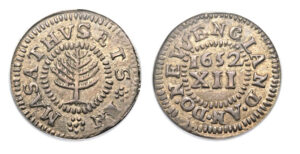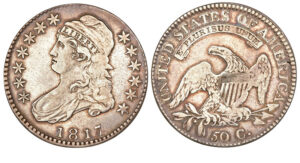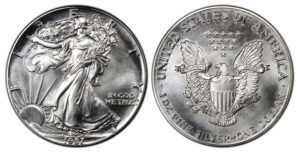
Silver is again rising in its investment importance. Here’s a look at its ups and downs through the years.
English Colony Silver from 1652
In the early days of the English colonies, all coins were in short supply and, in most cases, urgently needed by merchants importing goods from Britain. This shortage of coined gold and silver meant that even the most wealthy of families were unable to put away a stock of precious metals to protect themselves against future misfortunes. By 1652, the shortage of silver coins was becoming an increasing problem, especially in the Massachusetts colony. Most of the trade was required by law to be with Great Britain but the colonists also traded illegally with South America and Africa.
In 1652, Massachusetts authorities created their own silver coins to solve the silver coin shortage. This was in violation of British law which reserved that privilege to the government. However, in 1649, King Charles had been executed and the government was under the control of Puritan forces led by Oliver Cromwell.
The political leadership in Massachusetts was also Puritan, which meant the English government turned a blind eye to the Massachusetts coinage.

COURTESY HERITAGE AUCTIONS
Silver in the 1700s
In the 1700s, silver became easier to obtain for merchants and wealthier families. Much was of Spanish-American origin from the mints of Mexico City, Potosí and Lima. By the 1760s there was a sufficient supply for normal purposes.
The fighting at Lexington in 1775, which marked the opening battle of the war, sent shock waves through the colonies. Those who opposed independence, moved their portable treasures, such as gold and silver, to safer climes. The pro-independence faction realized their property was on the line and would be needed by the rebel forces fighting to achieve a new nation.
The war ended in 1783 and silver, especially in the form of coins, was in short supply. Congress had used every artifice at its command to obtain gold and silver to pay for war materials. The nation was so poor that Congress could barely pay its own salaries and expenses. Continental paper currency had depreciated to almost nothing while gold and silver coins were rarely seen.
Silver Under the 1787 Constitution
The economic situation changed dramatically after the 1787 Constitution was ratified. One of George Washington’s first acts was to name Alexander Hamilton as Secretary of the Treasury. Hamilton, through loans obtained from Holland, was instrumental in putting the government on a firm financial footing. In January 1791, Hamilton presented to Congress a plan for a mint and coinage. It was signed into law in April 1792 and created a bimetallic system of coinage, where gold and silver carried equal weight. In reality, gold was of little domestic importance and silver became the key metal of commerce and hoarding.
Silver coinage at the new Philadelphia Mint was relatively heavy in the late 1790s and early 1800s but some of it, especially dollars, tended to be exported to the Orient and Caribbean.
In 1804, through the efforts of Mint Director Elias Boudinot, the government took steps to stifle this outflow of precious metals by stopping the coinage of silver dollars and gold eagles ($10 pieces).
It should be noted that silver did continue to flow to China but most of the coins sent were Spanish, not American. By 1830, however, the increasing export of American goods to China leveled the playing field and silver was no longer as important in that trade.

COURTESY HERITAGE AUCTIONS
Silver After 1804
The 1804 change in coinage had long-term effects on banking and the supply of silver coins for the public. For the first time, silver, in the form of American-made coins, was readily available to the public through the banking system.
Wages were low compared to today but even laborers were able to lay aside a small stock of silver coins, usually in the form of half dollars, the most common coin struck by the mints until the late 1830s.
In 1834, the weights of gold coins were reduced to meet the international ratio of gold to silver and for the first time, gold was readily available to the average citizen. During the late 1830s and for most of the 1840s gold and silver both circulated freely though gold was more used for foreign trade than silver.
For most people in the 1830s and 1840s, however, silver was still the metal of choice for laying aside.
In 1848, the discovery of gold in California led to heavy coinages of this metal, but there was an unexpected side effect. There was so much gold that silver was less often found and became more valuable.
By the summer of 1850, silver was seen but rarely in the marketplace. Bullion dealers had stripped banks of their silver coins in exchange for gold. The public also gave up their small stocks of silver coins in exchange for the premium. The only American money in daily use were copper coins and small gold dollars.

COURTESY HERITAGE AUCTIONS
Congress Reforms Silver Coinage
In 1853, Congress solved the coinage problem and once more silver was in the hands of the public. There was a catch because the weights of the minor silver coins were reduced so they were no longer of full value. A half dollar, for example, was worth only about 45 cents in gold. Still, the public was once again able to lay aside a small stock for emergencies.
In general, the 1850s were years of prosperity for the public. Silver coins were easily obtained and were kept on hand as needed by the public.
Civil War Brings Change
By June of 1862 coined gold and silver had disappeared from the marketplace, to be exported or melted for their intrinsic worth. Such coins continued to circulate on the West Coast, because of special conditions that applied in this region.
During the 1860s very few people were laying aside silver or gold as a hedge against the future since both metals were hard to come by.
All of this changed after 1873. The government succeeded in putting minor silver coins back into the marketplace. However, silver began to drop in value because of increased quantities being mined in the West. The Trade dollar was introduced in 1873 to halt the drop in value by exporting silver to the Orient, but the idea was not a success.
Gold maintained its value and after 1878 could be obtained at the banks by simply presenting paper money in exchange. This dichotomy between gold and silver led to abandoning silver as an item to lay aside in favor of gold.

COURTESY PCGS
The Morgan Dollar
The introduction of the Morgan dollar in March 1878 did little to change the situation. Silver continued its decline in value. Small gold coins, especially half and quarter eagles, remained the best choice for many years.
Until the late 1920s, there was little or no change in the way the public laid aside money for emergencies. The general safety of the banking system also led to paper being kept for emergencies.
At the end of the 1920s, the stock market crash proved a bad omen even though the Treasury stabilized the market by early in 1930. It was not long, however, before a second crash caused massive problems and banks began to fail at an alarming rate. Those with paper money (on federally-chartered banks) and gold fared well for the time being but others saw life savings vanish overnight.
Gold Leaves the Marketplace
In 1933 the government demonetized gold and forced ordinary citizens to hand over their small stockpiles for paper currency.
It was not until early 1942, and the massive orders for war materials, that the average family was able to feel secure. Coin dealers laid aside rolls of silver coins for future sales but there was little or no hoarding of this metal. The value of an ounce of silver was still in the doldrums.
The end of World War II provided yet another change in the role silver played in the economy. By 1960, an ever-growing American economy began to affect the value of metals. The standard silver coining value of about $1.29 fell by the wayside by 1963. The last year for 90 percent silver proved to be 1964. The hoarding of silver coins now became a fact of life.
Silver Leaves the Marketplace
During the late 1960s and early 1970s, the hoarding of silver coins grew apace with the increase in the value of an ounce of silver. This led one group of investors, the Hunt brothers, to attempt control of the overall silver market. Silver reached $50 per ounce in early 1980 but many economists felt it was too much, too soon.
As predicted, silver did collapse in the early 1980s. Astute investors returned to this market and hoarding of silver.
Following 9/11, there was increased interest in laying aside silver and other metals as a hedge against emergencies and inflation. One of the underpinnings of the post–9/11 hoarding of silver was that silver coins would be of more value in the event of a disaster. This belief has never gone to a practical test and perhaps never will.
Mints Begin Striking Coins with One Ounce of Silver
In 1986, the government introduced one-ounce “coins” of gold and silver which are bullion in the form of a coin. The sales figures generally follow the state of the economy.
Then came Covid. And what will come next?
This article about silver’s investment importance previously appeared in COINage magazine. To subscribe click here. Article by R.W Julian.












